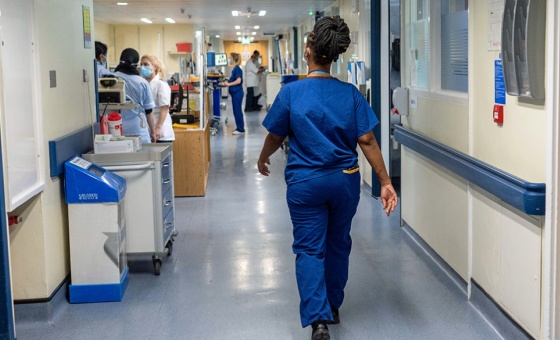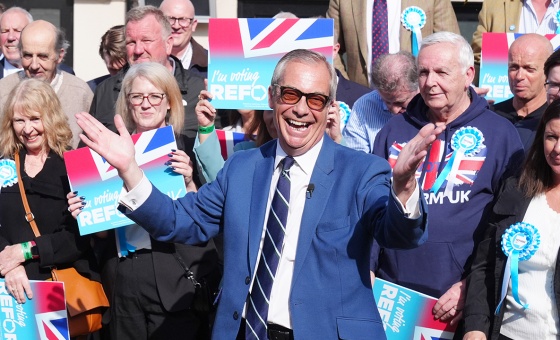This is the last article you can read this month
You can read more article this month
You can read more articles this month
Sorry your limit is up for this month
Reset on:
Please help support the Morning Star by subscribing here
AS THE 2017 general-election campaign developed it became clear that Labour’s election manifesto, its campaigning leadership and its army of activists were transforming the way elections are conducted.
Corbyn gathered an enthusiastic crowd wherever he appeared. Despite a fierce media offensive against Labour — and a dirty diversion alleging deep-rooted anti-semitism in the party — the Tory 20-point lead evaporated.
But, as the publication this week of the report “The work of Labour Party’s Governance and Legal Unit in relation to anti-semitism, 2014-2019” reveals, it was a Labour election campaign of two halves.
On one hand a massive outpouring of enthusiasm for a campaigning leadership and transformative manifesto, and behind the scenes a conspiracy to denigrate the leadership and rubbish the manifesto grounded in the barely hidden desires of key figures in Labour’s bureaucracy to risk losing the election in order to dispatch the Corbyn leadership.
The party apparatus at national and too often at regional level, was staffed by people wildly out of sympathy with the Corbyn leadership, deeply antagonistic to the party’s increasingly popular manifesto and riddled with right-wing factionalising.
The two MPs charged with co-ordinating Labour’s election campaign, party chair Ian Lavery MP and Jon Trickett MP, have now revealed how their vital work was undermined.
They say they couldn’t get campaign data from the party apparatus or feedback from canvassing and were kept in the dark about spending. When it became clear that Labour needed to shift to an offensive mode they were advised to devote key resources into solid Labour seats, most especially those defended by right wingers.
The Labour report reveals the existence of a secretive “Ergon House Project” where massive sums were secretly reassigned for factional purposes
Labour lost the 2017 general election by a handful of votes and Lavery and Trickett conclude: “It is possible that the actions of these party staff denied us a Labour government that would have transformed millions of lives.”
In that election campaign our ruling class had two objectives. The first was to reconstitute the Tory Party as a credible party of government. The second was to make the Labour Party safe, once again, for continuity capitalism.
Today, the beginning of realistic working-class politics lies in the recognition that these two objectives have, in the main, been achieved.
The question is, can this temporary stabilisation of normal politics be maintained in the transformed circumstances in which the Covid-19 emergency has compounded the underlying and deepening crisis of the global capitalist system.
Labour’s future depends on how it responds to these twin challenges, whether it follows other social-democratic parties into decline and electoral oblivion or resumes its hegemonic project.
The conclusion many people have reached following the election of Sir Kier Starmer as leader of the Labour Party is that disunity on the left needs to be overcome if the promise of the last few years and the near victory in the 2017 general election is once again to become a possibility.
It is certainly true, in narrow Labour Party terms, that disunity on the left was a major factor in the shift that saw a very large proportion of people who approved of Labour’s radical manifesto and backed Corbyn then vote to elect as party leader someone whose first act has been to rehabilitate the unsavoury gang of renegades who did most to subvert that leadership and now seeks to sideline the report which shows how damaging was this gang of saboteurs.
The election of the new leadership saw the careful construction of a campaign to present Starmer as the unity candidate able to overcome the divisions which were so evident throughout the Corbyn leadership and which set a parliamentary claque — increasingly co-ordinated by the two main right-wing factions — against the bulk of Labour’s membership and the main trend among trade-union-affiliated members.
It is worth looking at the two main structures through which Labour’s right wing organises among the membership, in the unions and most especially in local government and the party machine.
Labour First is the latest iteration of the pro-Nato, pro-US trend rooted in cold-war politics and wedded to Britain’s so-called ‘independent’ nuclear deterrent.
Its leading lights overlap with defence-industry business interests with a somewhat declining connection to right-wing circles in the engineering and nuclear industries. A concentration of MP supporters in the Midlands had as its titular head Labour’s former deputy leader Tom Watson.
In tandem with the election of the new leadership it has now combined with Progress in a new entity — “Labour to Win.”
Progress has a different and newer pedigree in that is most closely identified with Tony Blair’s leadership and New Labour’s willing embrace of neoliberalism and imperial war.
With less working-class pretensions than Labour First — and aside from its PLP contingent — it is especially active in local government where many of its supporters can be found with an interest in planning, development, construction and outsourced service delivery.
Its founders include Midlands MP Liam Byrne, the author of the idiotic note to the incoming Coalition Treasury ministers — “Dear Chief Secretary, I’m afraid there is no money. Kind regards — and good luck! Liam,” which was much used by the Tories to deflect blame for the 2008 financial crash from the banks onto the spending regime of Gordon Brown’s government.
Another founder was Derek Draper, who survived a series of scandals to resign from Labour in 2019 saying: “It seems to me that the party is basically stupid and then every now and again sensible people have to take it over so it can win but what an effort that is and it never lasts.”
Immensely well-funded by big-business donors, Progress fell on hard times once Lord Sainsbury turned off the funding tap. Apart from funding the Lib Dems and various pro-EU campaigns the grocery peer stumped up £3.5 million of the £4.7 million that Progress pocketed.
This new lash-up has its internal contradictions. Some of the MPs, even from both factions, represent working-class Leave-voting seats and are driven to ambivalence on Brexit, while others still yearn to reverse or subvert the referendum result.
So what of the left?
The long standing Campaign for Labour Party Democracy blamed Momentum for failing to agree on a list NEC of candidates and said it had “tried to engage in direct discussions with Momentum to explore the possibility of a united centre-left slate for the two vacancies. These discussions proved to be fruitless.”
Since the election Momentum has called for “unity, reflection and comradely debate on the way forward” for the left which it agrees is “disastrously split.”
The CLPD has a long track record of organising within Labour’s structures and Momentum won its spurs in mobilising activists to concentrate resources in key elections. But they do different things and at the decisive levels in their respective organisations have different priorities and divergent ideological positions.
This reflects the reality that Labour’s left is a very heterogeneous creature with a weakened relationship with the trade-union left and an attenuated connection to working-class communities, and is insufficiently embedded in the anti-war and anti-austerity movements which were essential in creating the Corbyn moment.
It is nevertheless a vitally important pole of activity in the Labour Party and the judgement on people who obstruct constructive agreement and necessary compromise will be harsh.
But beyond this it needs to engage much more actively with the working class where it is organised and where it can be mobilised. This demands a campaigning stance in constituencies and an active engagement with the left in the trade unions not only to achieve a convergence on policy questions but also to draw the trade unions decisively into Labour’s internal struggles.
There needs to be a more active involvement in mass campaigning, in local struggles against austerity, in anti-war activities, most especially with the Peoples Assembly Against Austerity, now fronted by the very able Laura Pidcock.
Breaking out of the Labour Party bubble is an essential first step. The Tory Party gave Labour an object lesson in the political and ideological power of language.
While the great majority of Labour’s support misunderstood reactionary rhetoric, xenophobia and nationalist posturing as the essence of the Brexit issue the Tories tapped into powerful undercurrents in working-class communities that saw fidelity to the referendum result as a marker of political honesty.
Labour lost trust in areas of its traditional support and the political figures most responsible for this loss of trust are elevated to leadership precisely because liberal illusions have a powerful hold still in Labour.
It is by bringing the language and life of the working class as it actually exists into Labour’s inner life that the Labour left’s efforts can begin to mean something of greater significance.
In their various analyses of the present moment all of the Labour left elements have had some useful and constructive things to say. All recognise that transformative though it was for the party the Corbyn phenomenon made insufficient contact with the working class and that disunity and division over Brexit fatally compromised Labour’s unique appeal and the trust that Corbyn’s leadership had begun to win.
Labour is battered but not broken. Labour held on to something of its 2017 gains. Although its vote was down to 32 per cent this was still greater than that won in 2010 and again in 2015 and in numerical terms was greater than Tony Blair’s total in 2005.
Labour has a reconstituted core support centred on big cities and London, defined in class terms as made up of the austerity generations of people who live uncertain lives and lack security and property.
It cannot reach towards hegemonic status among working people — and thus win an electoral majority no longer held hostage to a hostile parliamentary party — without coming to terms with the reality that the class divide in politics finds a reflection in and is institutionalised within the party. Fighting for policies and leadership is class struggle.
In the telling words of Paul O’Connell: “It is a big mistake to pathologise the Labour right and dismiss them as bitter careerists devoid of ideas — the instinct to preserve the status quo is class politics and ideology, they’re the personification of capital in the labour movement — remove a few, the tendency remains.”











